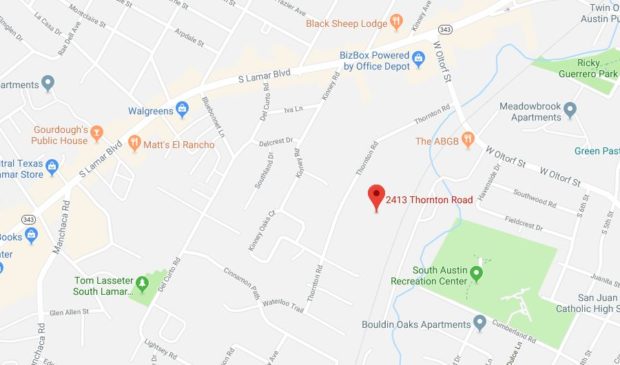South Lamar neighbors to get office traffic instead of residential traffic
Tuesday, March 20, 2018 by
Jack Craver Nearly two years ago, the Planning Commission voted 10-1 to recommend a zoning change that would allow a 70-unit apartment building to be built on a vacant lot at 2413 Thornton Road.
As is often the case in zoning battles, nearby neighbors objected to a development that they feared would bring additional traffic to an already overburdened road.
While commissioners sympathized with the neighbors’ concerns, they pointed out that the current zoning for the property would actually allow the developer, PSW Real Estate, to build a large commercial project that would generate far more vehicle trips. Plus, the proposed residential project would include seven two-bedroom units affordable to those at 60 percent of the median family income, a rare offer from a private developer.
In the months that followed, however, PSW faced continued resistance from the South Lamar Neighborhood Association and City Council Member Ann Kitchen, who represents the area. In March 2017, Council rejected PSW’s request, instead granting zoning for only 55 units. In response, PSW said that it would no longer bother with the residential project and instead build a large commercial project.
PSW is hoping to break ground on a 60,000-square-foot office building by summer.
Ross Wilson, the president of PSW’s Austin office, said the company is perfectly happy with the way things turned out now. It’s the company’s first commercial project.
“We’re really excited about the design we’re doing,” he said. “The experience on the commercial side is good for us.”
Wilson’s satisfaction with the outcome does not mask his disappointment with the political process that led to it.
“It’s the only time that we’ve tried to downzone a property, and it’s the only zoning case that we have not been successful with,” he said.
Despite a near-unanimous endorsement from the Planning Commission, the proposal appeared dead on arrival by the time it reached Council, he said.
“A number of Council members were absent from the dais throughout the conversation. There were very few questions from a majority on the zoning case,” he said. “It certainly felt to us that a decision was pretty well made.”
In private talks with Kitchen, Wilson said the Council members asked whether the firm would be willing to forfeit the affordable units in order to bring the total number of units down from 70 to 63.
“That’s not how we would approach this project,” Wilson recalled saying. “We think the affordability component is important.”
A representative from Kitchen’s office disputed Wilson’s assertion that Kitchen had suggested removing the affordable units as part of a compromise, saying in an email that they were “disappointed” by his characterization of the talks.
“There may be some confusion on the reduction of units,” they said. “There was discussion about reducing (the) number of units in response to trips generated as a way to make residential development more in scale with area infrastructure capacity but not in terms of reducing affordable units.”
In addition, they continued, while the office building is slated to generate more vehicle trips, neighbors aren’t as bothered by the prospect of heavier traffic that comes and goes only twice a day during the weekdays and will generally flow in the opposite direction of residents who are leaving the neighborhood in the morning or driving home in the evening.
Finally, by building the commercial project, PSW will have to make a larger payment to the city to account for the impact of its development on city infrastructure.
Indeed, Commissioner Tom Nuckols, the only commissioner who sided with the neighborhood association at the time, said that the larger project would “perversely” be preferable because it would lead PSW to cough up enough money to cover the widening of Thornton Road that neighbors have long sought. At the time, PSW tried to counter by saying that if the residential zoning were approved, the company would not only pay for the upgrades but would do them itself immediately.
Kim Johnson, the president of the neighborhood association, said he is not sure when or if the road will be widened to accommodate the new development. He is happy to report, however, that Thornton Road is now part of the Residential Permit Parking Program, which has reduced parking on the street. He noted that the neighborhood has embraced affordable housing projects in the past, including the nearby Bluebonnet Studios, a 107-unit complex on South Lamar that serves single adults.
Not everybody is happy about the incoming office building, though. On March 11, neighborhood association member Bryan King sent out a message to fellow members bemoaning PSW’s plan to cut down a heritage tree “that will let (PSW) build 30,000 sq ft more building.”
In an email to Carol Gibbs of the city of Austin’s Neighborhood Assistance Center, King asked whether the neighbors could do anything to “prevent PSW cutting down MORE heritage trees in our neighborhood?”
Gibbs replied that the tree had been approved for removal by staff, due to a variety of criteria, including that it had already lost one of its arms.
She concluded: “I know that’s not the answer Bryan wanted to hear, though.”
The Austin Monitor’s work is made possible by donations from the community. Though our reporting covers donors from time to time, we are careful to keep business and editorial efforts separate while maintaining transparency. A complete list of donors is available here, and our code of ethics is explained here.
You're a community leader
And we’re honored you look to us for serious, in-depth news. You know a strong community needs local and dedicated watchdog reporting. We’re here for you and that won’t change. Now will you take the powerful next step and support our nonprofit news organization?









